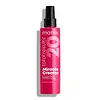What's inside
What's inside
 Key Ingredients
Key Ingredients

No key ingredients
 Benefits
Benefits

 Concerns
Concerns

 Ingredients Side-by-side
Ingredients Side-by-side

Water
Skin ConditioningCocos Nucifera Oil
MaskingAmodimethicone
Polyquaternium-37
Phenoxyethanol
PreservativePropylene Glycol Dicaprylate/Dicaprate
EmollientParfum
MaskingAcetamide Mea
HumectantLactamide Mea
HumectantDimethicone PEG-7 Phosphate
CleansingPPG-1 Trideceth-6
Skin ConditioningTrideceth-6
EmulsifyingBehentrimonium Chloride
PreservativeGlycine Soja Oil
EmollientPrunus Amygdalus Dulcis Oil
Skin ConditioningXylose
HumectantLactic Acid
BufferingEthylhexylglycerin
Skin ConditioningCetrimonium Chloride
AntimicrobialHydrolyzed Vegetable Protein Pg-Propyl Silanetriol
Skin ConditioningLinalool
PerfumingCoumarin
PerfumingSodium Hydroxide
BufferingWater, Cocos Nucifera Oil, Amodimethicone, Polyquaternium-37, Phenoxyethanol, Propylene Glycol Dicaprylate/Dicaprate, Parfum, Acetamide Mea, Lactamide Mea, Dimethicone PEG-7 Phosphate, PPG-1 Trideceth-6, Trideceth-6, Behentrimonium Chloride, Glycine Soja Oil, Prunus Amygdalus Dulcis Oil, Xylose, Lactic Acid, Ethylhexylglycerin, Cetrimonium Chloride, Hydrolyzed Vegetable Protein Pg-Propyl Silanetriol, Linalool, Coumarin, Sodium Hydroxide
Water
Skin ConditioningAlcohol Denat.
AntimicrobialPropylene Glycol
HumectantPolyurethane-48
PEG-60 Hydrogenated Castor Oil
EmulsifyingSodium Benzoate
MaskingCetyl Ethylhexanoate
EmollientBis-Isobutyl PEG/PPG-20/35/Amodimethicone Copolymer
Lactic Acid
BufferingPolysorbate 80
EmulsifyingButylene Glycol
HumectantGluconolactone
Skin ConditioningHydrolyzed Keratin
HumectantLinalool
PerfumingMethyl Benzoate
Perfuming
 Reviews
Reviews

Ingredients Explained
These ingredients are found in both products.
Ingredients higher up in an ingredient list are typically present in a larger amount.
Lactic Acid is another well-loved alpha hydroxy acid (AHA). It is gentler than glycolic acid but still highly effective.
Its main role is to exfoliate the surface of the skin by loosening the “glue” that holds dead skin cells together. Shedding those old cells leads to smoother, softer, and more even-toned skin.
Because lactic acid molecules are larger than glycolic acid, they don’t penetrate as deeply. This means they’re less likely to sting or irritate, making it a great choice for beginners or those with sensitive skin.
Like glycolic acid, it can:
Lactic acid also acts as a humectant (like hyaluronic acid). It can draw water into the skin to improve hydration and also plays a role in the skin's natural moisturizing factor (NMF) in the form of sodium lactate.
Studies show it can boost ceramide production to strengthen the skin barrier and even help balance the skin’s microbiome.
To get results, choose products with a pH between 3-4.
Lower strengths (5-12%) focus on surface exfoliation; higher strengths (12% and up) can reach deeper in the dermis (deeper, supportive layer) to improve skin texture and firmness over time.
Though it was originally derived from milk, most modern lactic acid used in skincare is vegan. It is made through non-dairy fermentation to create a bio-identical and stable form suitable for all formulations.
When lactic acid shows up near the end of an ingredient list, it usually means the brand added just a tiny amount to adjust the product’s pH.
Legend has it that Cleopatra used to bathe in sour milk to help reduce wrinkles.
Lactic acid is truly a gentle multitasker: it exfoliates, hydrates, strengthens, and brightens. It's a great ingredient for giving your skin a smooth, glowing, and healthy look without the harshness of stronger acids.
Read more about some other popular AHA's here:
Learn more about Lactic AcidLinalool is a fragrance and helps add scent to products. It's derived from common plants such as cinnamon, mint, citrus, and lavender.
Like Limonene, this ingredient oxidizes when exposed to air. Oxidized linalool can cause allergies and skin sensitivity.
This ingredient has a scent that is floral, spicy tropical, and citrus-like.
Learn more about LinaloolWater. It's the most common cosmetic ingredient of all. You'll usually see it at the top of ingredient lists, meaning that it makes up the largest part of the product.
So why is it so popular? Water most often acts as a solvent - this means that it helps dissolve other ingredients into the formulation.
You'll also recognize water as that liquid we all need to stay alive. If you see this, drink a glass of water. Stay hydrated!
Learn more about Water